NEWSLETTER 10/2012 19. October 2012
NEW PARTNERS:
- Wayne M. Itano, Museum of Natural History, University of Colorado, Boulder, USA
- Dipl.Ing. Lutz Andres, Staufenberg, Germany
- Natalia Ruocco, Instituto Nacional de Investigación y Desarrollo Pesquero (INIDEP), Buenos Aires, Argentina
---------------------------------------------------------------------------------------------------------------------------------------------------------
NEW IMAGES AT SHARK-REFERENCES:
Many thanks to:
Chris Avila, Toronto (Homepage) for the images of Pseudoginglymostoma brevicaudatum (GÜNTHER, 1867), e.g.:
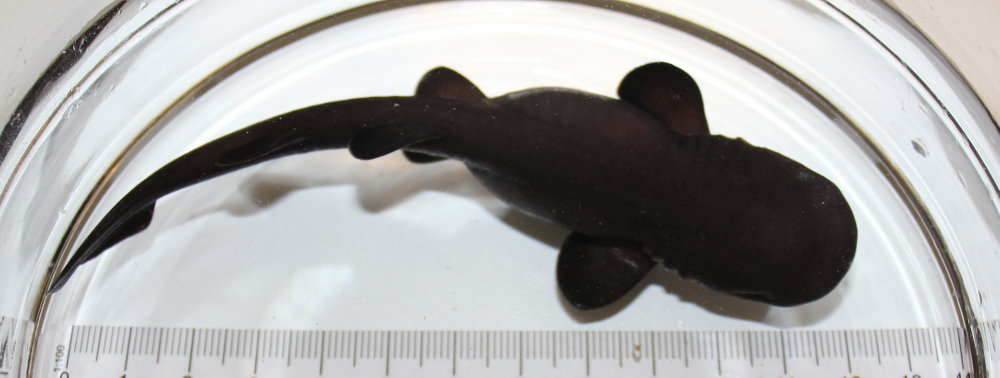
Arve Lynghammar, University of Tromsø, Norway for images of Amblyraja radiata (DONOVAN, 1808), e.g.:
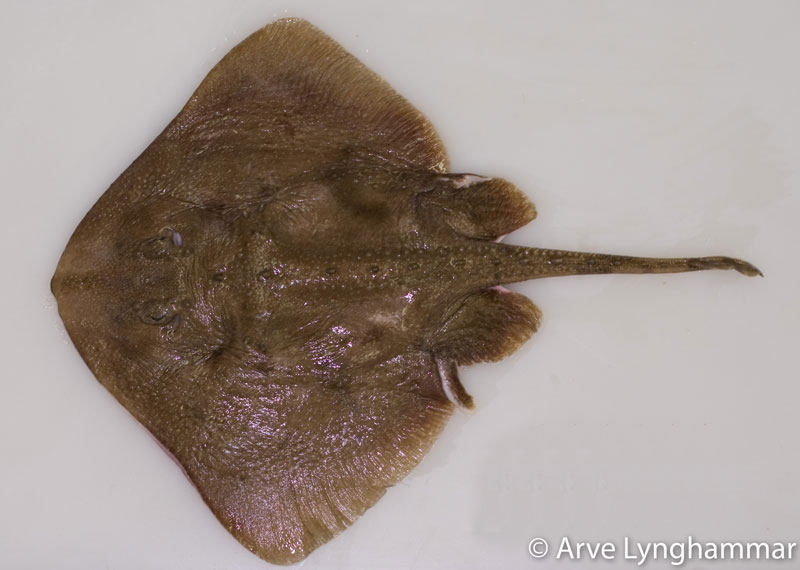
Prof. Francisco Concha, Universidad de Valparaíso, Chile for images of Hexanchus griseus (BONNATERRE, 1788), Sympterygia brevicaudata (COPE, 1877) and Sympterygia lima (POEPPIG, 1835):
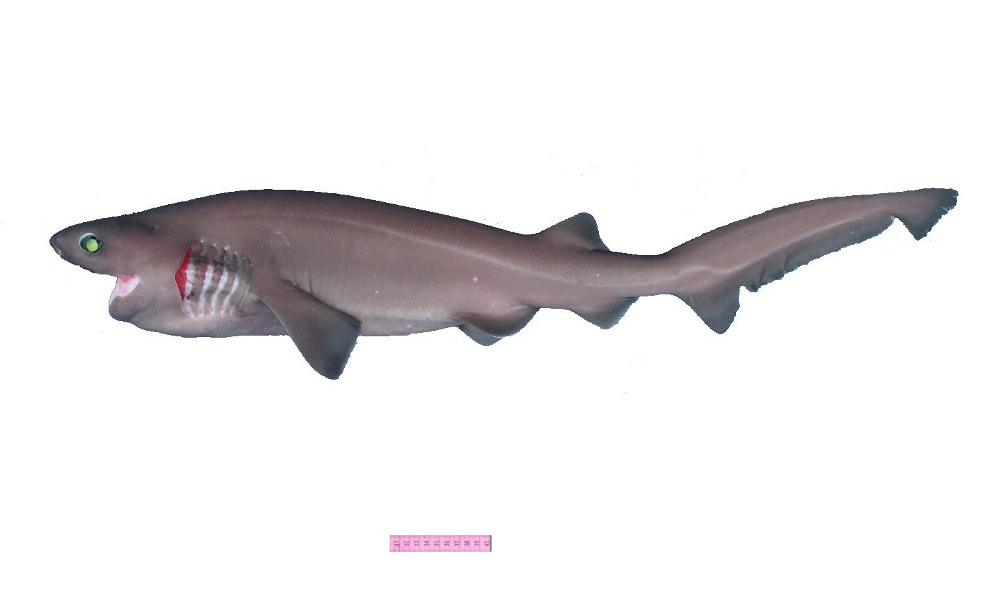
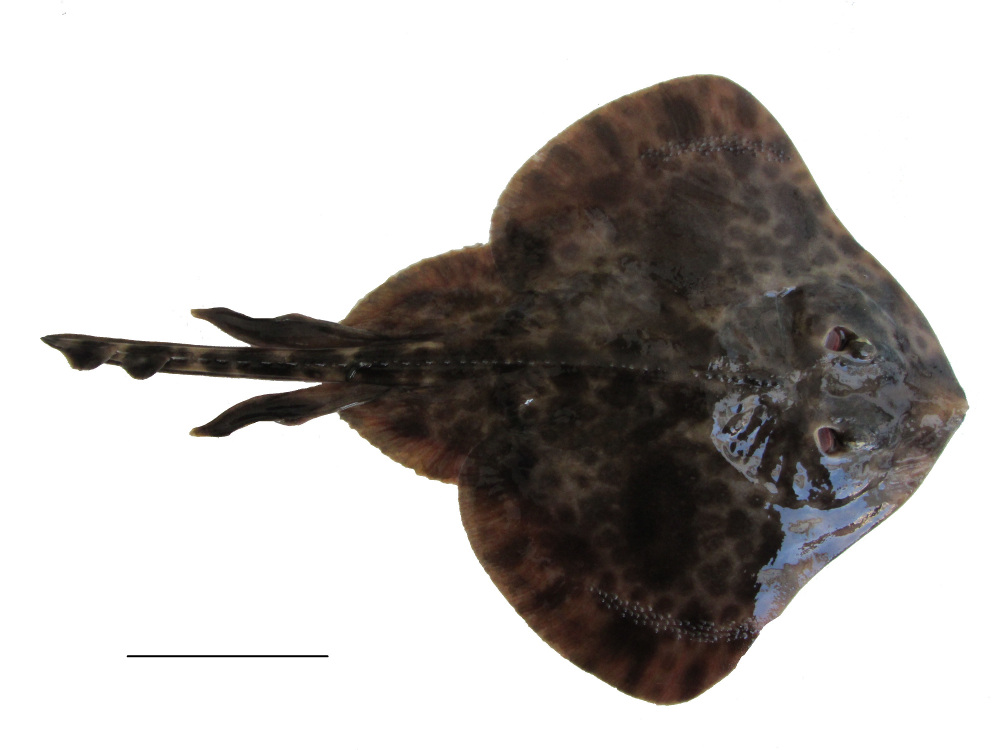
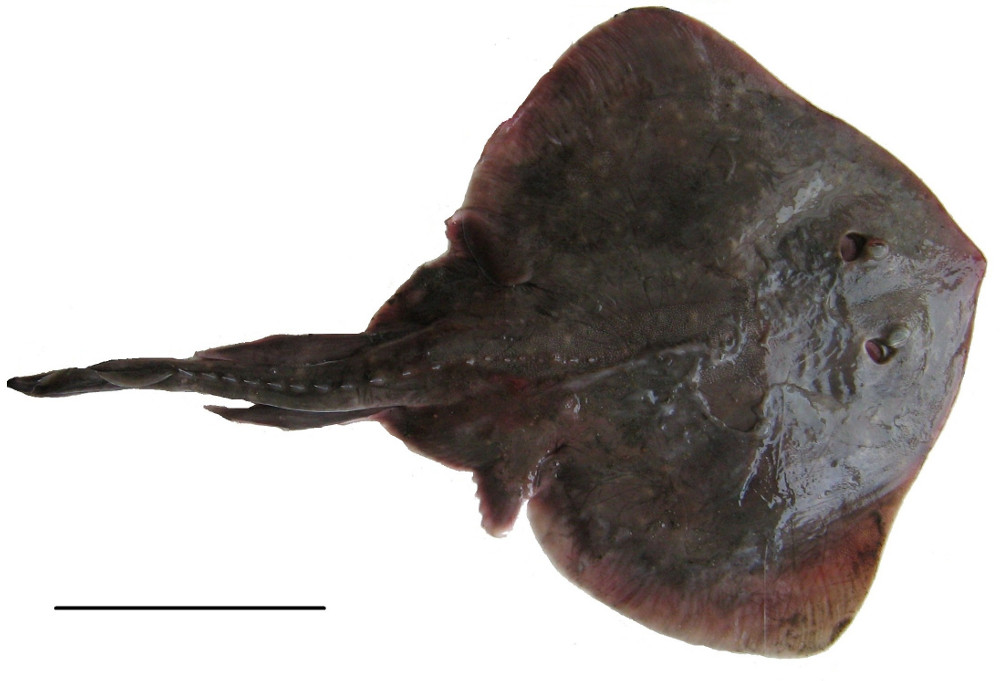
Claudio Barria, Department of Natural Resources, Institute of Marine Sciences of Barcelona (ICM), Spain for an image of Etmopterus spinax (LINNAEUS, 1758):
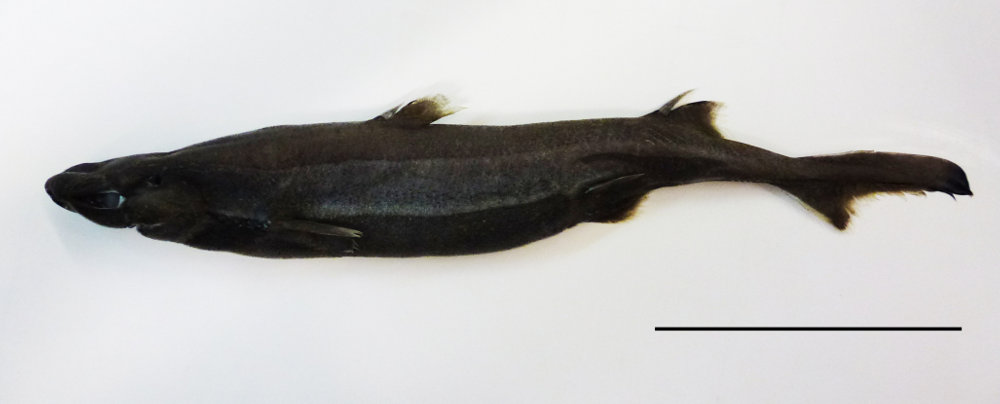
Please send your images to shark-references!
---------------------------------------------------------------------------------------------------------------------------------------------------------
Many thanks for sending missing papers:
Chip Cotton
Lynghammar Arve
Dipl.Ing. Lutz Andres
Oliver Landemaine
Shark-References would kindly like to ask you for your contribution to this project.
Please support www.shark-references.com and send missing papers (not listed papers or papers without the infosymbol) to juergen.pollerspoeck@shark-references.com
---------------------------------------------------------------------------------------------------------------------------------------------------------
New menu item at shark-references.com - Host-Parasites List
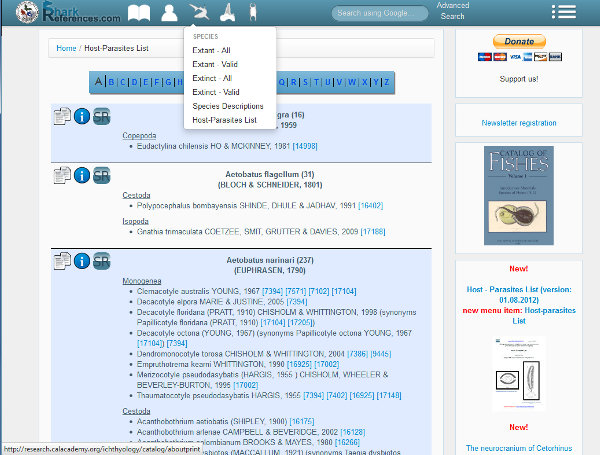
Please send your publications about parasites of elasmobranchs to: juergen.pollerspoeck@shark-references.com
---------------------------------------------------------------------------------------------------------------------------------------------------------
NEWS FROM PARTNER:
Please support the new project of William Eschmeyer, Ronald Fricke and Richard van der Laan!
Catalog of Fishes - version of 2 October 2012 (Continuously updated since the early 1980s.)
New Projects: (1) Priority applies to Family-group names. It did not in early years. As classifications are refined with use of more subfamilies and tribes, it is required to use the oldest available family-group name for these new taxa. Early authors did not provide authorships and dates for families, and it is very difficult to find them. A second preliminary list of available family-group names of fishes is included in this version. Click here for the list.

---------------------------------------------------------------------------------------------------------------------------------------------------------
New described species:
Fossil:
IVANOV, A.O. & NESTELL, M. & NESTELL, G. (2012): New jalodontid chondrichthyans from the Middle Permian of West Texas, USA. Historical Biology, 24 (4): 359-368
New species: Isacrodus marthae, Texasodus varidentatus
New genus: Isacrodus, Texasodus
Abstract: The teeth of two new genera of jalodontid sharks have been found in the strata of the Middle Permian in the Guadalupe Mountains area of West Texas. Isacrodus marthae gen. et sp. nov. occurs in the Williams Ranch Member, Cutoff Formation, Roadian. A second taxon Texasodus varidentatus gen. et sp. nov. is found in beds of the Hegler and Pinery Members, Bell Canyon Formation, Upper Wordian-Lower Capitanian. The family Jalodontidae includes Jalodus, Adamantina and the two new genera; Isacrodus and Texasodus.
---------------------------------------------------------------------------------------------------------------------------------------------------------
New Paper
Rezent Papers:
AMIN, R. & RITTER, E. & KENNEDY, P. 2012 A geospatial analysis of shark attack rates for the east coast of Florida: 1994-2009. Marine and Freshwater Behaviour and Physiology, 45 (3): 185-198 http://dx.doi.org/10.1080/10236244.2012.715742
ANANDHAKUMAR, C. & RAJ, G.D. & UMA, A. & TIRUMURUGAAN, K.G. & RAJA, A. & KUMANAN, K. 2012 Mating behaviour and breeding of the grey bamboo shark, Chiloscyllium griseum Müller & Henle, 1838 in captivity. Indian Journal of Fisheries, 59 (3): 149-152
ANDERSON, E.T. & FRASCA, S. & ASAKAWA, M.G. & FATZINGER, M.H. & JOHNSON, J. & MARCHETERE, K. & GOODALE, L. & RISATTI, G.R. & HARMS, C.A. 2012 Splenic mycobacteriosis in an Atlantic guitarfish, Rhinobatos lentiginosus Garman (vol 35, pg 541, 2012). Errata. Journal of Fish Diseases, 35 (9): 709 http://dx.doi.org/10.1111/j.1365-2761.2012.01411.x
BIERY, L.E. 2012 Using shark catch data to estimate the magnitude and global distribution of the shark fin trade. MS Thesis, University of British Columbia
BLEVINS, E.L. & LAUDER, G.V. 2012 Rajiform locomotion: three-dimensional kinematics of the pectoral fin surface during swimming in the freshwater stingray Potamotrygon orbignyi. Journal of Experimental Biology, 215 (18): 3231-3241 http://dx.doi.org/10.1242/jeb.068981
BORNATOWSKIA, H. & WEDEKIN, L.L. & HEITHAUS, R.R. & MARCONDES, M.C.C. & ROSSI-SANTOS, M.R. 2012 Shark scavenging and predation on cetaceans at Abrolhos Bank, eastern Brazil. Journal of the Marine Biological Association of the United Kingdom, in press http://dx.doi.org/10.1017/S0025315412001154
CHABANET, P. & DURVILLE, P. & FRICKE, R. & AMIR, H. & VIGLIOLA, L. 2012 Checklist of the coral reef fishes of Baa Atoll, Maldives. Atoll Research Bulletin, 590: 143-161
CONCEIÇÃO, K. & MONTEIRO-DOS-SANTOS, J. & SEIBERT, C.S. & SILVA, P.I. & MARQUES, E.E. & RICHARDSON, M. & LOPES-FERREIRA, M. 2012 Potamotrygon cf. henlei stingray mucus: Biochemical features of a novel antimicrobial protein. Toxicon, 60 (5): 821-829 http://dx.doi.org/10.1016/j.toxicon.2012.05.025
CROLL, D.A. & NEWTON, K.M. & WENIG, K. & GALVÁN-MAGAÑA, F. & O’SULLIVAN, J. & DEWAR, H. 2012 Movement and habitat use by the spine-tail devil ray in the Eastern Pacific Ocean. Marine Ecology Progress Series, 465: 193-200 http://dx.doi.org/10.3354/meps09900
DONLEY, J.M. & SEPULVEDA, C.A. & AALBERS, S.A. & MCGILLIVRAY, D.G. & SYME, D.A. & BERNAL, D. 2012 Effects of temperature on power output and contraction kinetics in the locomotor muscle of the regionally endothermic common thresher shark (Alopias vulpinus). Fish Physiology and Biochemistry, 38 (5): 1507-1519 http://dx.doi.org/10.1007/s10695-012-9641-1
DRIGGERS, W.B. & CAMPBELL, M.D. & HOFFMAYER, E.R. & INGRAM, G.W. 2012 Feeding chronology of six species of carcharhinid sharks in the western North Atlantic Ocean as inferred from longline capture data. Marine Ecology Progress Series, 465: 185-192 http://dx.doi.org/10.3354/meps09901
ECHWIKHI, K. & SAIDI, B. & BRADAI, M.N. & BOUAIN, A. 2012 Preliminary data on elasmobranch gillnet fishery in the Gulf of Gabès, Tunisia. Journal of Applied Ichthyology, in press http://dx.doi.org/10.1111/jai.12022
ESPINOZA, M. & CLARKE, T.M. & VILLALOBOS-ROJAS, F. & WEHRTMANN, I.S. 2012 Ontogenetic dietary shifts and feeding ecology of the rasptail skate Raja velezi and the brown smoothhound shark Mustelus henlei along the Pacific coast of Costa Rica, Central America. Journal of Fish Biology, in press http://dx.doi.org/10.1111/j.1095-8649.2012.03410.x
FARGO, J.J. 2012 Dynamics of Marine Fish Assemblages in Hecate Strait, British Columbia. Canadian Technical Report of Fisheries and Aquatic Sciences, 2996: 1-65
FURUMITSU, K. & KUME, G. & MINEI, Y. & YAMAGUCHI, A. 2012 Reproductive Biology of the Shortspine Spurdog Squalus cf. mitsukurii in the Southwest Waters of Japan. Bulletin of Marine Science, 88 (4): 987-1001 http://dx.doi.org/10.5343/bms.2012.1009
GONZÁLEZ-ARMAS, R. & HO, J.-S. & HERNÁNDEZ-TRUJILLO, S. 2012 A new regional record for the pandarid copepod, Dinemoura producta (Müller, 1785), parasitic on the shortfin mako shark captured off Cabo San Lucas, Mexico. Crustaceana, 85 (8): 1019-1023 http://dx.doi.org/10.1163/156854012X650205
GRIM, J.M. & DING, A.A. & BENNETT, W.A. 2012 Differences in activity level between cownose rays (Rhinoptera bonasus) and Atlantic stingrays (Dasyatis sabina) are related to differences in heart mass, hemoglobin concentration, and gill surface area. Fish Physiology and Biochemistry, 38 (5): 1409-1417 http://dx.doi.org/10.1007/s10695-012-9628-y
HABEGGER, M.L. & MOTTA, P.J. & HUBER, D.R. & DEAN, M.N. 2012 Feeding biomechanics and theoretical calculations of bite force in bull sharks (Carcharhinus leucas) during ontogeny. Zoology, in press http://dx.doi.org/10.1016/j.zool.2012.04.007
HAZEN, E.L. & JORGENSEN, S. & RYKACZEWSKI, R.R. & BOGRAD, S.J. & FOLEY, D.G. & JONSEN, I.D. & SHAFFER, S.A. & DUNNE, J.P. & COSTA, D.P. & CROWDER, L.B. & BLOCK, B.A. 2012 Predicted habitat shifts of Pacific top predators in a changing climate. Nature Climate Change: 5pp http://dx.doi.org/10.1038/nclimate1686
HEUPEL, M.R. & SIMPFENDORFER, C.A. & OLSEN, E.M. & MOLAND, E. 2012 Consistent movement traits indicative of innate behavior in neonate sharks. Journal of Experimental Marine Biology and Ecology, 432-433: 131-137 http://dx.doi.org/10.1016/j.jembe.2012.07.013
JAINE, F.R.A. & COUTURIER, L.I.E. & WEEKS, S.J. & TOWNSEND, K.A. & BENNETT, M.B. & FIORA, K. & RICHARDSON, A.J. 2012 When Giants Turn Up: Sighting Trends, Environmental Influences and Habitat Use of the Manta Ray Manta alfredi at a Coral Reef. PLoS ONE, 7 (10): e46170 http://dx.doi.org/10.1371/journal.pone.0046170
JANSE, M. & KIK, M.J.L. 2012 Mycobacterium avium granulomas in a captive epaulette shark, Hemiscyllium ocellatum (Bonnaterre). Journal of Fish Diseases, in press http://dx.doi.org/10.1111/j.1365-2761.2012.01444.x
JARVIS, H.C. & MATHENY, L.M. & CLANTON, T.O. 2012 Stingray injury to the webspace of the foot. Orthopedics, 35 (5): e762-e765 http://dx.doi.org/10.3928/01477447-20120426-38
KIM, S.L. & TINKER, M.T. & ESTES, J.A. & KOCH, P.L. 2012 Ontogenetic and Among-Individual Variation in Foraging Strategies of Northeast Pacific White Sharks Based on Stable Isotope Analysis. PLoS ONE, 7 (9): e45068 http://dx.doi.org/10.1371/journal.pone.0045068
LANG, A.W. & HABEGGER, M.L. & MOTTA, P.J. 2012 Shark Skin Drag Reduction. Encyclopedia of Nanotechnology. B. Bhushan (editor). Berlin: Springer, Part 19: 2394-2400 http://dx.doi.org/10.1007/978-90-481-9751-4_266
LANGLOIS, T.J. & RADFORD, B.T. & VAN NIEL, K.P. & MEEUWIG, J.J. & PEARCE, A.F. & ROUSSEAUX, C.S.G. & KENDRICK, G.A. & HARVEY, E.S. 2012 Consistent abundance distributions of marine fishes in an old, climatically buffered, infertile seascape. Global Ecology and Biogeography, 21 (9): 886-897 http://dx.doi.org/10.1111/j.1466-8238.2011.00734.x
LOPEZ-LOPEZ, L. & PRECIADO, I. & VILLAMOR, B. & VELASCO, F. & IGLESIAS, M. & NOGUEIRA, E. & GUTIERREZ-ZABALA, J.L. & OLASO, I. 2012 Is juvenile anchovy a feeding resource for the demersal community in the Bay of Biscay? On the availability of pelagic prey to demersal predators. ICES Journal of Marine Science, 69 (8): 1394-1402 http://dx.doi.org/10.1093/icesjms/fss117
MARANCIK, D.P. & DOVE, A.D. & CAMUS, A.C. 2012 Experimental infection of yellow stingrays Urobatis jamaicensis with the marine leech Branchellion torpedinis. Diseases of Aquatic Organisms, 101 (1): 51-60 http://dx.doi.org/10.3354/dao02508
MCPHERSON, D.L. & BLAIYOK, K.V. & MASSE, W.B. 2012 Lethal Ramming of Sharks by Large Jacks (Carangidae) in the Palau Islands, Micronesia. Pacific Science, 66 (3): 327-333 http://dx.doi.org/10.2984/66.3.6
MENEZES, G.M. & ROSA, A. & MELO, O. & PORTEIRO, F. 2012 Annotated list of demersal fishes occurring at Sedlo Seamount, Azores north-east central Atlantic Ocean. Journal of Fish Biology, 81 (3): 1003-1018 http://dx.doi.org/10.1111/j.1095-8649.2012.03355.x
MOTTA, P.J. & HABEGGER, M.L. & LANG, A.W. & HUETER, R. & DAVIS, J. 2012 Scale morphology and flexibility in the shortfin mako Isurus oxyrinchus and the blacktip shark Carcharhinus limbatus. Journal of Morphology, 273 (10): 1096-1110 http://dx.doi.org/10.1002/jmor.20047
OTA, Y. & HOSHINO, O. & HIROSE, M. & TANAKA, K. & HIROSE, E. 2012 Third-stage larva shifts host fish from teleost to elasmobranch in the temporary parasitic isopod, Gnathia trimaculata (Crustacea; Gnathiidae). Marine Biology, 159 (10): 2333-2347 http://dx.doi.org/10.1007/s00227-012-2018-2
PÉREZ-JIMÉNEZ, J.C. & ROCHA-OLIVARES, A. & SOSA-NISHIZAKI, O. 2012 Morphological and molecular differentiation of smooth-hound sharks (Genus Mustelus, Family Triakidae) from the Gulf of California. Journal of Applied Ichthyology, in press http://dx.doi.org/10.1111/jai.12042
SAUNDERS, B. 2012 Discovery of Australia's Fishes: A History of Australian Ichthyology to 1930 Csiro Publishing, 2012: 520 pp
SCHLUESSEL, V. & BLECKMANN, H. 2012 Spatial learning and memory retention in the grey bamboo shark (Chiloscyllium griseum). Zoology, in press http://dx.doi.org/10.1016/j.zool.2012.05.001
SPATH, M.C. & BARBINI, S.A. & FIGUEROA, D.E. 2012 Feeding habits of the apron ray, Discopyge tschudii (Elasmobranchii: Narcinidae), from off Uruguay and northern Argentina. Journal of the Marine Biological Association of the United Kingdom, in press http://dx.doi.org/10.1017/S0025315412000665
STEPANEK, R. & KRIWET, J. 2012 Contributions to the skeletal anatomy of freshwater stingrays (Chondrichthyes, Myliobatiformes): 1. Morphology of male Potamotrygon motoro from South America. Zoosystematics and Evolution, 88 (2): 145-158 http://dx.doi.org/10.1002/zoos.201200013
THEISS, S.M. & DAVIES, W.I.L. & COLLIN, S.P. & HUNT, D.M. & HART, N.S. 2012 Cone monochromacy and visual pigment spectral tuning in wobbegong sharks. Biology Letters, in press http://dx.doi.org/10.1098/rsbl.2012.0663
TILLETT, B.J. & FIELD, I.C. & BRADSHAW, C.J.A. & JOHNSON, G. & BUCKWORTH, R.C. & MEEKAN, M.G. & OVENDEN, J.R. 2012 Accuracy of species identification by fisheries observers in a north Australian shark fishery. Fisheries Research, 127-128: 109-115 http://dx.doi.org/10.1016/j.fishres.2012.04.007
WANG, B. & LI, Z.-R. & CHI, C.-F. & ZHANG, Q.-H. & LUO, H.-Y. 2012 Preparation and evaluation of antioxidant peptides from ethanol-soluble proteins hydrolysate of Sphyrna lewini muscle. Peptides, 36 (2): 240-250 http://dx.doi.org/10.1016/j.peptides.2012.05.013
YAMAGUCHI, Y. & KAIYA, H. & KONNO, N. & IWATA, E. & MIYAZATO, M. & UCHIYAMA, M. & BELL, J.D. & TOOP, T. & DONALD, J.A. & BRENNER, S. & VENKATESH, B. & HYODO, S. 2012 The fifth neurohypophysial hormone receptor is structurally related to the V2-type receptor but functionally similar to V1-type receptors. General and Comparative Endocrinology, 178 (3): 519-528 http://dx.doi.org/10.1016/j.ygcen.2012.07.008
Fossil:
BURROW, C.J. & TURNER, S. 2012 Scale structure of putative chondrichthyan Gladbachus adentatus Heidtke & Krätschmer, 2001 from the Middle Devonian Rheinisches Schiefergebirge, Germany. Historical Biology, in press http://dx.doi.org/10.1080/08912963.2012.722761
CUNY, G. & LIARD, R. & DEESRI, U. & LIARD, T. & KHAMHA, S. & SUTEETHORN, V. 2012 Freshwater hybodont sharks from the Late Jurassic – Early Cretaceous of northeastern Thailand: stratigraphical and palaeobiogeographical implications. Abstract. Terra Nostra, 2012 (3):
FISCHER, J. & FRANZ, M. & KAISER, S. 2012 Oxygen and strontium isotopes from fossil bioapatite from the Middle Triassic (Anisian-Ladinian) Muschelkalk Sea. Abstract. Terra Nostra, 2012 (3): 54-55
FISCHER, J. & VOIGT, S. & SCHNEIDER, J.W. & FRANECK, F. 2012 The shark fauna and ist nurseries from the Triassic Madygen lake (Kyrgyzstan). Abstract. Terra Nostra, 2012 (3): 55
FRANECK, F. & SCHNEIDER, J.W. & FISCHER, J. & KOGAN, I. & BUCHWITZ, M. & SPINDLER, F. & VOIGT, S. 2012 Microvertebrate remains from the non-marine Triassic Madygen Formation of Kyrgyzstan. Abstract. Terra Nostra, 2012 (3): 57-58
HEIDTKE, U.H.J. 2012 Weitere Erkenntnisse über Lebachacanthus colosseus (Elasmobranchii: Xenacanthida) aus der mittleren Meisenheim-Formation (Autunium, Unterperm) von Niederkirchen (Pfalz). [Further discoveries on Lebachacanthus colosseus (Elasmobranchii: Xenacanthida) from the middle Meisenheim-formation (Autunian, Earlv Permian) of Niederkirchen (Palatinate)]. Mitteilungen der POLLICHIA, 96: 1-4
ITANO, W.M. & HOUCK, K.J. & LOCKLEY, M.G. 2012 Systematics and occurrences of Edestus (Chondrichthyes) worldwide and new occurrences from Colorado and Texas. Historical Biology, 24 (4): 397-410 http://dx.doi.org/10.1080/08912963.2012.658569
IVANOV, A.O. & NESTELL, M. & NESTELL, G. 2012 New jalodontid chondrichthyans from the Middle Permian of West Texas, USA. Historical Biology, 24 (4): 359-368 http://dx.doi.org/10.1080/08912963.2012.662229
JOHNSON, G.D. 2012 Possible origin of the xenacanth sharks Orthacanthus texensis and Orthacanthus platypternus in the Lower Permian of Texas, USA. Historical Biology, 24 (4): 369-379 http://dx.doi.org/10.1080/08912963.2012.669128
KLUG, S. & KRIWET, J. 2012 Divergence estimates of major squalomorph clades (Chondrichthyes, Neoselachii) and their impact on phylogenetic hypotheses. Abstract. Terra Nostra, 2012 (3): 94
KLUG, S. & KRIWET, J. 2012 First Miocene holomorphic stingray (Chondrichthyes, Myliobatiformes, Dasatidae) from SE Asia. Abstract. Terra Nostra, 2012 (3): 93
KRIWET J. & ENGELBRECHT, A. & MORS, T. & REGUERO, M. & TAMBUSSI, C. & STEPANEK, R. 2012 First chimeroid, batoid and shark records (Chondrichthyes: Holocephali, Elasmobranchii) from the uppermost horizons (Late Eocene, Telms 6 and 7) of the La Meseta Formation, Seymour Island, Antarctica. Abstract. Terra Nostra, 2012 (3):
LUND, R. & GREENFEST-ALLEN, E. & GROGAN, E.D. 2012 Habitat and diversity of the Bear Gulch fish: Life in a 318 million year old marine Mississippian bay. Palaeogeography, Palaeoclimatology, Palaeoecology, 342-343: 1-16 http://dx.doi.org/10.1016/j.palaeo.2012.04.016
SPINDLER, F. & FISCHER, J. 2012 The Second Evolution – Life reconstructions through the ages. Abstract. Terra Nostra, 2012 (3): 172
SULEJ, T. & NIEDZWIEDZKI, G. & BRONOWICZ, R. 2012 A new Late Triassic vertebrate fauna from Poland with turtles, aetosaurs, and coelophysoid dinosaurs. Journal of Vertebrate Paleontology, 32 (5): 1033-1041 http://dx.doi.org/10.1080/02724634.2012.694384
VEITSCHEGGER, K. & KRIWET, J. 2012 Systematic position of Prionace glauca (Linnaeus, 1758) inferred from CO1, with comments on the monophyly of carcharhinid sharks (Chondrichthyes, Carcharhiniformes). Abstract. Terra Nostra, 2012 (3):
WILSON, M.A. & ZATON, M. & AVNI, Y. 2012 Origin, palaeoecology and stratigraphic significance of bored and encrusted concretions from the Upper Cretaceous (Santonian) of southern Israel. Palaeobiodiversity and Palaeoenvironments, 92 (3): 343-352 http://dx.doi.org/10.1007/s12549-012-0082-8
---------------------------------------------------------------------------------------------------------------------------------------------------------
MISCELLANEOUS:
Cambrian Fossil Pushes Back Evolution of Complex Brains
ScienceDaily (Oct. 10, 2012) — Complex brains evolved much earlier than previously thought, as evidenced by a 520-million-year-old fossilized arthropod with remarkably well-preserved brain structures.
The remarkably well-preserved fossil of an extinct arthropod shows that anatomically complex brains evolved earlier than previously thought and have changed little over the course of evolution. According to University of Arizona neurobiologist Nicholas Strausfeld, who co-authored the study describing the specimen, the fossil is the earliest known to show a brain.
The discovery will be published in the Oct. 11 issue of the journal Nature.The remarkably well-preserved fossil of an extinct arthropod shows that anatomically complex brains evolved earlier than previously thought and have changed little over the course of evolution. According to University of Arizona neurobiologist Nicholas Strausfeld, who co-authored the study describing the specimen, the fossil is the earliest known to show a brain.
Embedded in mudstones deposited during the Cambrian period 520 million years ago in what today is the Yunnan Province in China, the approximately 3-inch-long fossil, which belongs to the speciesFuxianhuia protensa, represents an extinct lineage of arthropods combining an advanced brain anatomy with a primitive body plan.
The fossil provides a "missing link" that sheds light on the evolutionary history of arthropods, the taxonomic group that comprises crustaceans, arachnids and insects.
The researchers call their find "a transformative discovery" that could resolve a long-standing debate about how and when complex brains evolved.
"No one expected such an advanced brain would have evolved so early in the history of multicellular animals," said Strausfeld, a Regents Professor in the UA department of neuroscience.
According to Strausfeld, paleontologists and evolutionary biologists have yet to agree on exactly how arthropods evolved, especially on what the common ancestor looked like that gave rise to insects.
"There has been a very long debate about the origin of insects," Strausfeld said, adding that until now, scientists have favored one of two scenarios.
Some believe that insects evolved from the an ancestor that gave rise to the malacostracans, a group of crustaceans that include crabs and shrimp, while others point to a lineage of less commonly known crustaceans called branchiopods, which include, for example, brine shrimp.
Because the brain anatomy of branchiopods is much simpler than that of malacostracans, they have been regarded as the more likely ancestors of the arthropod lineage that would give rise to insects.
However, the discovery of a complex brain anatomy in an otherwise primitive organism such as Fuxianhuia makes this scenario unlikely. "The shape [of the fossilized brain] matches that of a comparable sized modern malacostracan," the authors write in Nature. They argue the fossil supports the hypothesis that branchiopod brains evolved from a previously complex to a more simple architecture instead of the other way around.
This hypothesis arose from neurocladistics, a field pioneered by Strausfeld that attempts to reconstruct the evolutionary relationships among organisms based on the anatomy of their nervous system. Conventional cladistics, on the other hand, usually look to an organism's overall morphology or molecular data such as DNA sequences.
Strausfeld, who holds appointments in other UA departments including evolutionary biology and entomology, has catalogued about 140 character traits detailing the neural anatomies of almost 40 arthropod groups.
"There have been all sorts of implications why branchiopods shouldn't be the ancestors of insects," he said. "Many of us thought the proof in the pudding would be a fossil that would show a malacostracan-like brain in a creature that lived long before the origin of the branchiopods; and bingo! -- this is what this is."
Strausfeld traveled to the Yunnan Key Laboratory for Palaeobiology at Yunnan University in Kunming, China, to join his collaborator, Xiaoya Ma, a postdoctoral fellow at London's Natural History Museum, in studying the brain anatomies of various fossil specimens. In the institute's collection, they came across the fossil of Fuxianhuia protensa described in the paper.
"I spent a frenetic five hours at the dissecting microscope, the last hours of my visit there, photographing, photographing, photographing," he said. "And I realized that this brain actually comprises three successive neuropils in the optic regions, which is a trait of malacostracans, not branchiopods."
Neuropils are portions of the arthropod brain that serve particular functions, such as collecting and processing input from sensory organs. For example, scent receptors in the antennae are wired to the olfactory neuropils, while the eyes connect to neuropils in the optic lobes.
When Strausfeld traced the fossilized outlines of Fuxianhuia's brain, he realized it had three optic neuropils on each side that once were probably connected by nerve fibers in crosswise pattern as occurs in insects and malacostracans. The brain was also composed of three fused segments, whereas in branchiopods only two segments are fused.
"In branchiopods, there are always only two visual neuropils and they are not linked by crossing fibers," Strausfeld said. "In principle, Fuxianhuia's is a very modern brain in an ancient animal."
The fossil supports the idea that once a basic brain design had evolved, it changed little over time, he explained. Instead, peripheral components such as the eyes, the antennae and other appendages, sensory organs, etc., underwent great diversification and specialized in different tasks but all plugged into the same basic circuitry.
"It is remarkable how constant the ground pattern of the nervous system has remained for probably more than 550 million years," Strausfeld added. "The basic organization of the computational circuitry that deals, say, with smelling, appears to be the same as the one that deals with vision, or mechanical sensation."
Story Source:
The above story is reprinted from materials provided byUniversity of Arizona, via EurekAlert!, a service of AAAS.
Note: Materials may be edited for content and length. For further information, please contact the source cited above.
Journal Reference:
1. Xiaoya Ma, Xianguang Hou, Gregory D. Edgecombe, Nicholas J. Strausfeld. Complex brain and optic lobes in an early Cambrian arthropod. Nature, 2012; 490 (7419): 258 DOI: 10.1038/nature11495
Disclaimer: This article is not intended to provide medical advice, diagnosis or treatment. Views expressed here do not necessarily reflect those of ScienceDaily or its staff.
This picture shows a nearly intact fossil of Fuxianhuia protensa. The inset shows the fossilized brain in the head of another specimen. The brain structures are visible as dark outlines. (Credit: Specimen photo: Xiaoya Ma; inset: Nicholas Strausfeld)


















